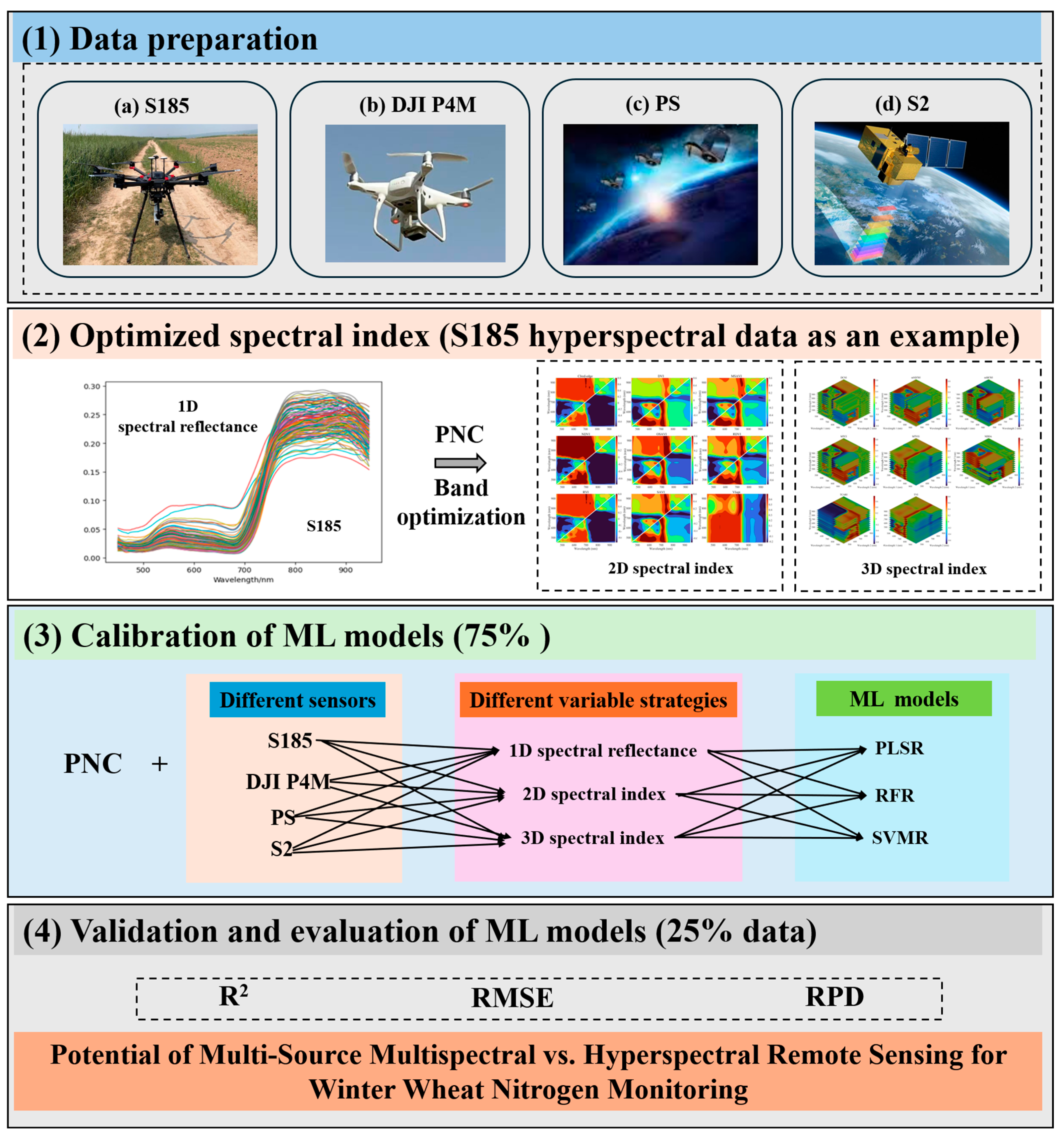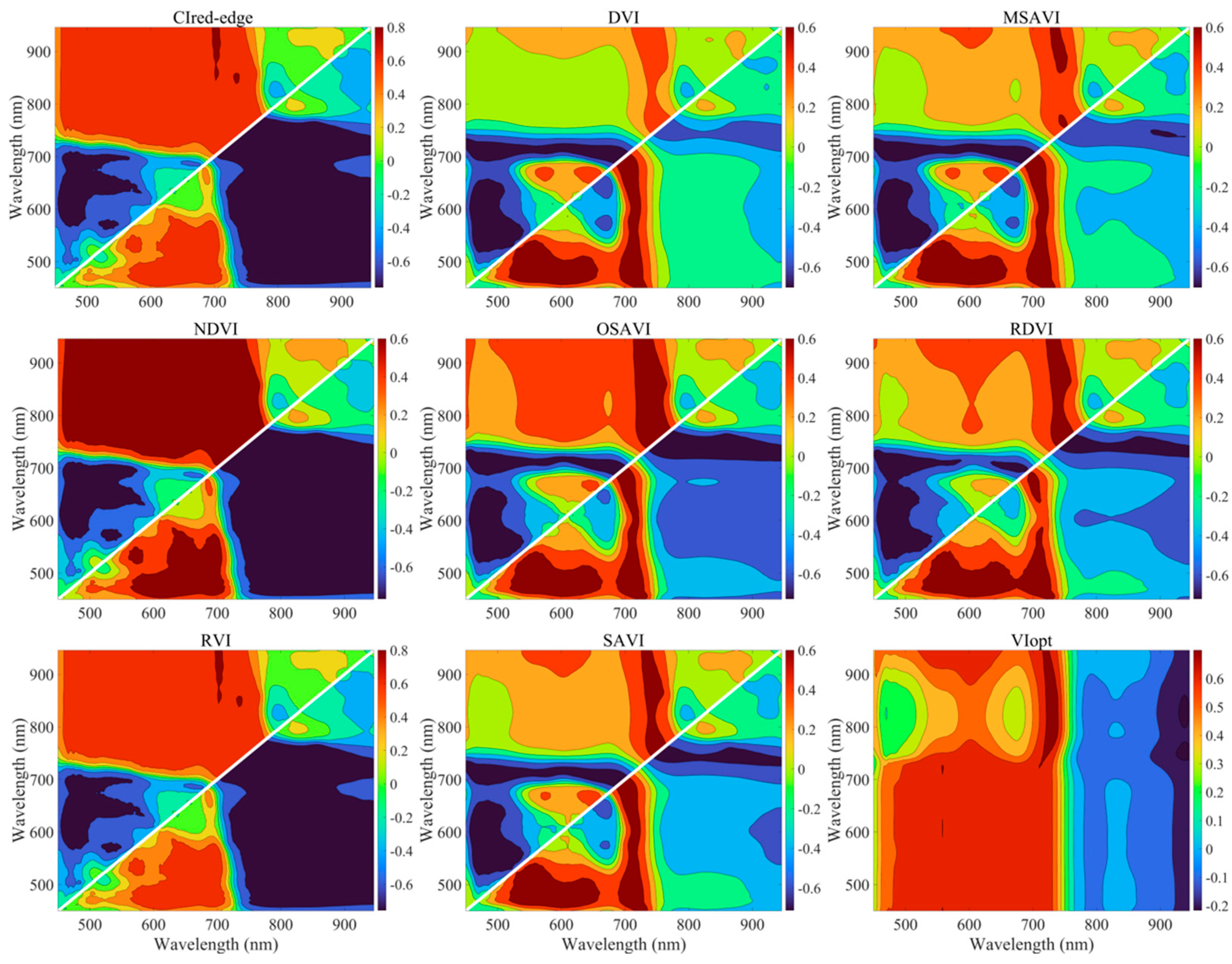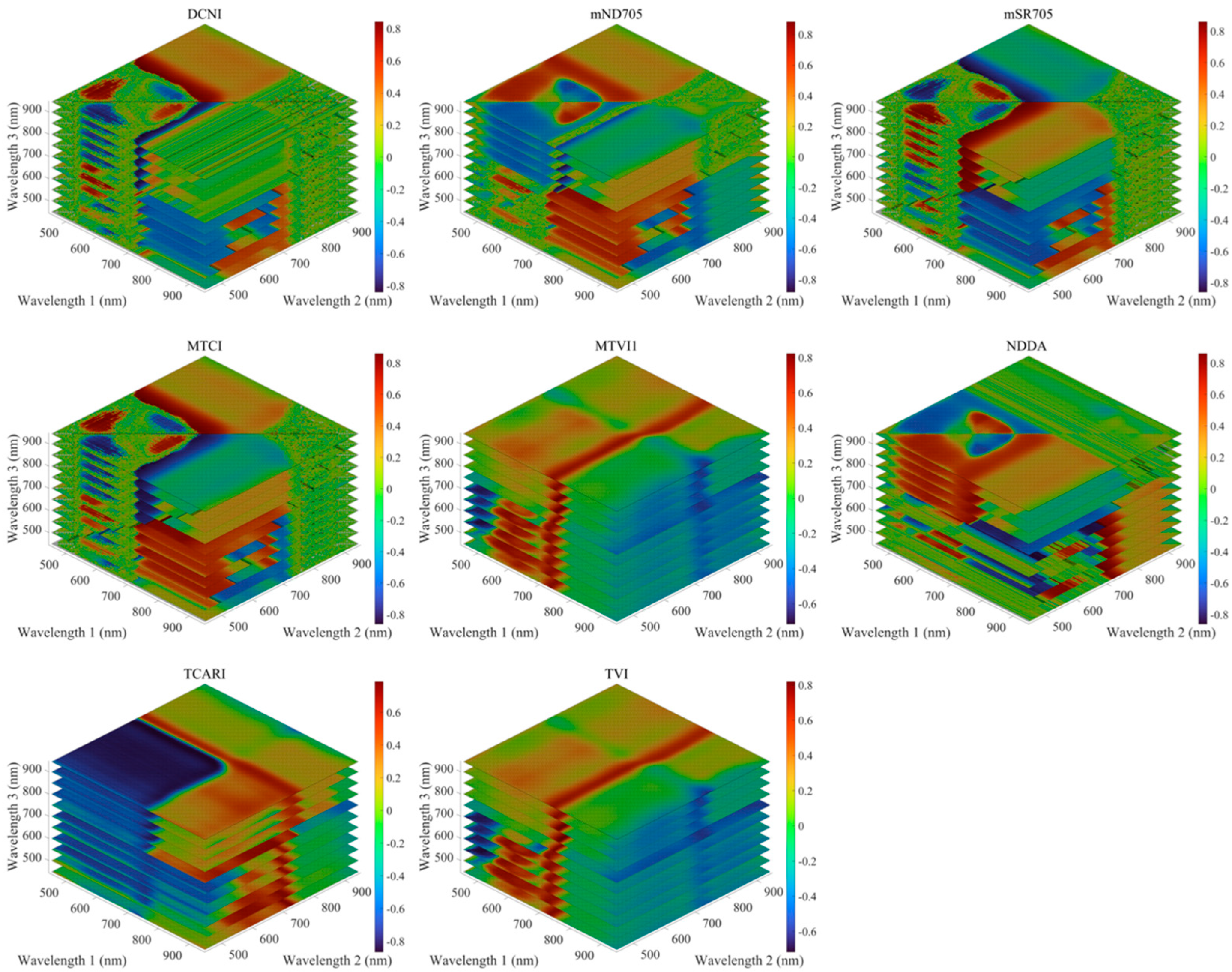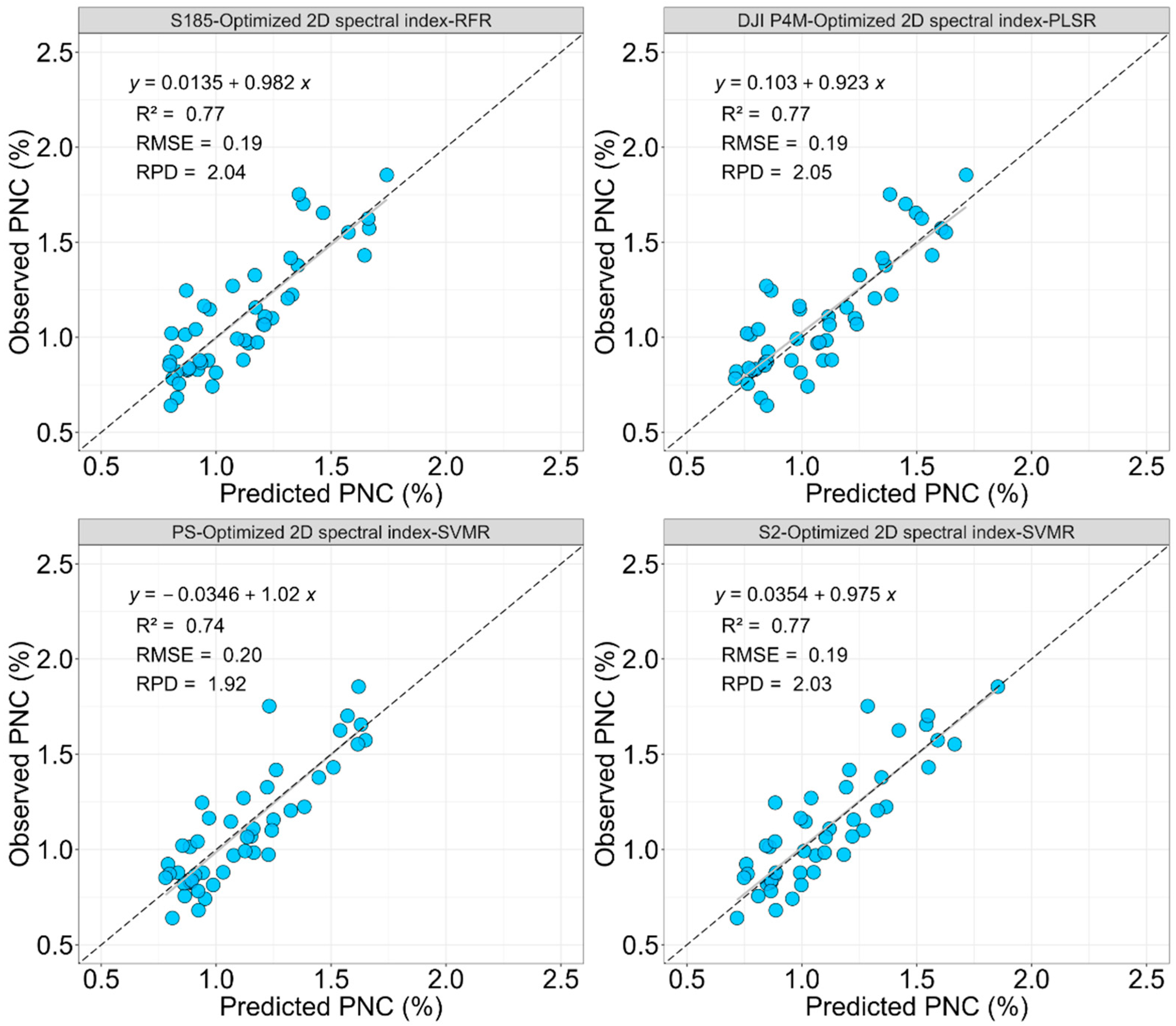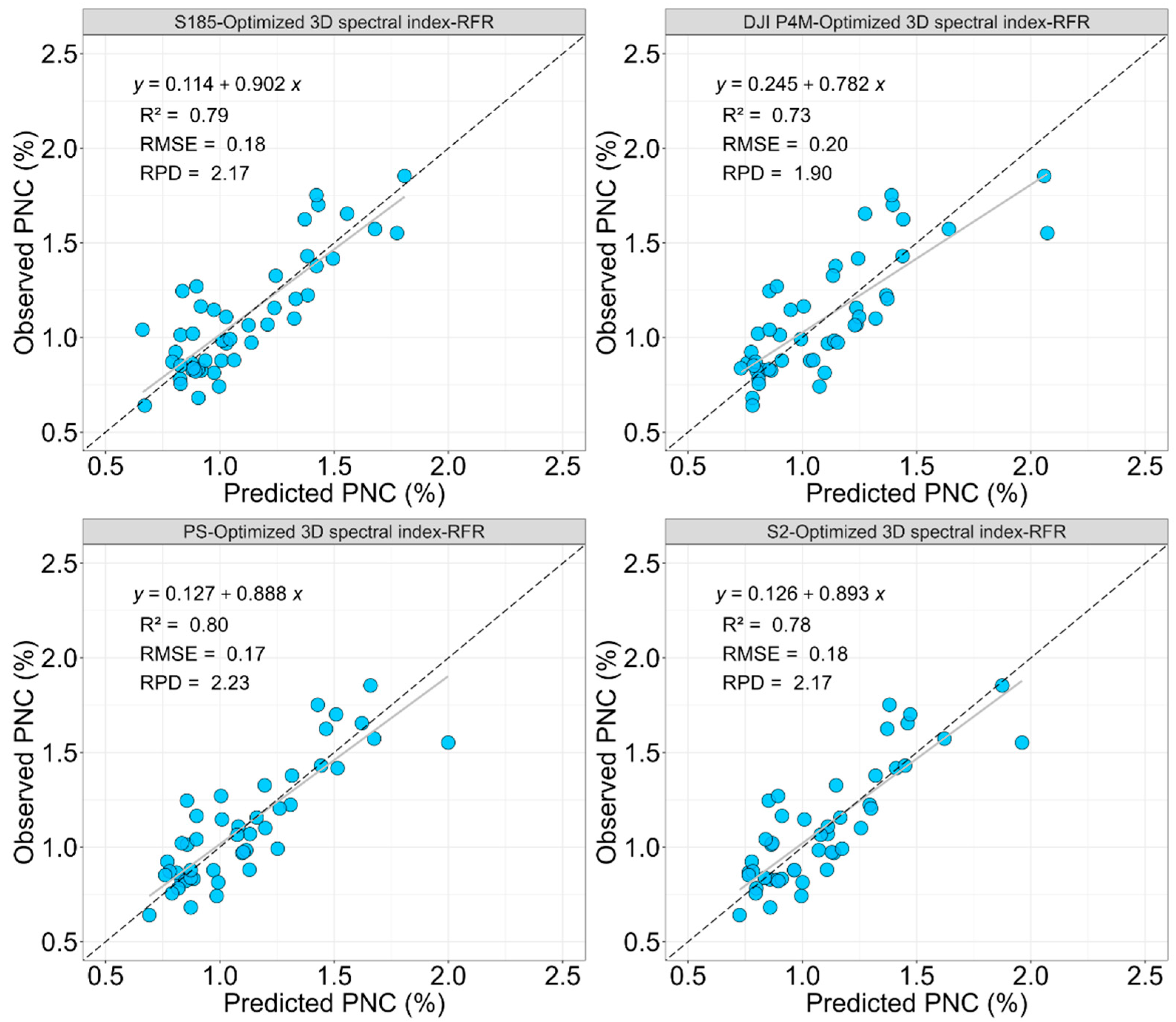1. Introduction
Wheat (
Triticum aestivum L.) is a fundamental crop for global food security [
1]. Achieving high yields of winter wheat typically requires substantial nitrogen (N) fertilizer inputs. However, excessive N application can lead to serious environmental issues, including greenhouse gas emissions and water contamination [
2]. Plant N concentration (PNC) serves as a key indicator of crop N status and plays a crucial role in guiding precision N fertilizer management strategies [
3]. Hence, timely and accurate assessment of crop PNC is essential for sustainable agricultural practices.
Traditional methods for determining crop PNC involve field destructive sampling and laboratory chemical analysis. Although highly accurate, they are time-consuming and costly, making them impractical for large-scale crop N monitoring. In contrast, remote sensing technologies have emerged as a powerful non-destructive alternative, playing an increasingly important role in monitoring crop nitrogen status over the past few decades [
4]. With the advancements in unmanned aerial vehicle (UAV) and satellite technologies, remote sensing has emerged as a key tool for monitoring crop growth and nutritional status [
5].
UAV hyperspectral remote sensing provides spectral reflectance data across adjacent narrow bands, delivering detailed spectral information of crop canopy characteristics [
6], which was widely applied in the estimation of winter wheat canopy N density [
7] and soil moisture [
8]. However, the high cost, limited coverage, and complex data processing processes of UAV hyperspectral remote sensing limit its application. In comparison, UAV multispectral sensors are easier to operate, less expensive, and involve simpler data processing, making them better suited for large-scale farm applications [
9]. Despite their practicality, multispectral UAVs have only a few spectral bands, which may not provide enough detailed information for accurate crop N concentration estimations. In addition, the short flight time of most UAV remote sensing systems makes them challenging to apply on a large scale. The development of satellite remote sensing provides an opportunity to extend the methods established by UAV remote sensing to a regional scale. Applications include estimation of biomass [
10], crop grain N uptake [
11], and yield prognosis [
12]. Although different types of sensors are widely used in crop monitoring, their differing capabilities in estimating N concentration have not been systematically evaluated. Balancing sensor accuracy, cost, and coverage has become a key challenge in crop N monitoring.
Hyperspectral sensors offer the benefit of having a large number of spectral bands, allowing for detailed and extensive spectral data, making one-dimensional (1D) spectral reflectance analysis the most intuitive approach for data analysis. However, hyperspectral data can suffer from the “curse of dimensionality” [
13], where the high number of features relative to the available sample size can lead to model overfitting, increased computational burden, and reduced generalization capability. Moreover, although hyperspectral bands contain information for estimating crop N concentration, their performance can be easily affected by atmospheric conditions and other background factors.
To improve robustness and simplify interpretation, researchers have increasingly focused on spectral indices, which are typically constructed from the reflectance values of two, three, or more specific bands [
14]. The Normalized Difference Vegetation Index (NDVI) and the Ratio Vegetation Index (RVI) are the earliest and widely forms of two-dimensional (2D) spectral indices [
15,
16]. Building on this, researchers proposed a series of classical 2D spectral indices, including Soil-adjusted vegetation index (SAVI) [
17], Modified soil-adjusted vegetation index (MSAVI) [
18], Optimized soil-adjusted vegetation index (OSAVI) [
19], etc. Recently, spectral indices constructed using three spectral bands, or three-dimensional (3D) spectral indices, have emerged as a promising approach to enhance the predictive capability of remote sensing models. Unlike traditional 1D reflectance or 2D spectral indices, 3D spectral indices can capture more complex spectral interactions and synergies among bands, potentially improving model performance for estimating crop biophysical parameters [
20]. However, the 3D spectral indices proposed so far are still very limited, involving Double-peak Canopy Nitrogen Index (DCNI) [
21] and Modified simple ratio index 705 (mSR705). Other 3D spectral indices have also been explored in recent studies, though they remain relatively few in number.
Although numerous spectral indices have shown promising results in diagnosing crop N status [
21], their effectiveness may vary across crops, cultivars, regions, and growth stages. The N dilution effect and variation in canopy structure were the main reasons that interfered with crop N estimation accuracy and none of the traditional spectral indices could accurately predict crop PNC across the entire growing season [
22]. Moreover, a traditional 2D or 3D spectral index is mostly a combination of bands selected by researchers under local conditions or based on experience. For hyperspectral sensors with numerous spectral bands, the traditional 2D or 3D spectral indices may omit spectral regions with critical spectral information [
23], potentially compromising the accuracy of PNC estimation. Thus, there is an urgent need to optimize the traditional 2D or 3D spectral indices by systematically selecting sensitive band combinations and evaluating their predictive performance through correlation analysis and model validation. Guo et al. [
24] estimated the potato canopy N content (CNC) based on an optimized 2D spectral index, and created a potato (
Solanum tuberosum L.) CNC distribution map using UAV remote sensing. Fan et al. [
25] compared and analyzed 1D UAV hyperspectral reflectance while also optimizing 2D and 3D spectral indices to estimate potato PNC, and found that the optimized 3D spectral index TBI5 outperformed the others, achieving the highest accuracy (R
2 = 0.65, RMSE = 0.39, NRMSE = 12.17%). Although multidimensional spectral indices led to considerable achievements in crop N monitoring, a comprehensive evaluation of multiple sensors for winter wheat PNC estimation remains unreported.
Recent research has emphasized the effectiveness of integrating machine learning (ML) models with remote sensing data to enhance the accuracy of crop N estimation [
26,
27]. Li et al. [
28] demonstrated that partial least squares regression (PLSR) combined with spectral reflectance significantly improved the estimation accuracy of winter wheat CNC; Random forest regression (RFR) and support vector machine regression (SVMR) also showed promising results in that respect, especially when combined with optimized spectral indices [
13].
This study contributes to precision agriculture by systematically comparing the effectiveness of UAV hyperspectral, UAV multispectral, and satellite multispectral sensors for PNC estimation. By employing spectral resampling to simulate multispectral data for the popular platforms (DJI Phantom 4 Multispectral (DJI P4M), PlanetScope (PS) and Sentinel-2A (S2)) from the S185 UAV hyperspectral data, this study bridges the gap between high-precision UAV systems and scalable satellite remote sensing technologies. PNC estimation models were constructed using 1D spectral reflectance and optimized 2D and 3D spectral indices from different sensors combined with PLSR, RFR, and SVMR algorithms, respectively. The primary objective was to assess the potential of different remote sensing technologies for estimating winter wheat PNC, considering cost, accuracy, and regional applicability.
4. Discussion
4.1. Comparative Performance of Different Sensors and Strategies
The findings highlighted the predictive capabilities of S185 hyperspectral and simulated (DJI P4M, PS, and S2) sensors for winter wheat PNC. Across all three strategies (1D spectral reflectance, optimized 2D and 3D spectral indices), the S185 hyperspectral sensor consistently demonstrated superior performance in most cases, confirming the value of hyperspectral data for precise PNC evaluation. However, the performance of simulated multispectral UAV and satellite sensors (DJI P4M, PS, and S2) approached that of hyperspectral data when combined with ML models, showcasing their practical application potential. Specifically, the PS based on 1D spectral reflectance strategy combined with SVMR performed the best in PNC prediction (R
2 = 0.79, RMSE = 0.18, RPD = 2.14), demonstrating a similar accuracy level to the S185 hyperspectral sensor (R
2 = 0.79, RMSE = 0.18, RPD = 2.13). This shows that, in the case of low spectral dimension, the satellite multispectral sensor could achieve superior prediction accuracy by using appropriate ML models (
Figure 5). Gao et al. [
43] reached a similar conclusion when predicting the soil aggregates by simulating satellite multispectral bands. The high dimensionality and multicollinearity of the 1D spectral reflectance data from the S185 sensor may have impacted the predictive capability of the PNC model [
13].
When using optimized 2D spectral indices, model performance varied among sensors too. The S185 hyperspectral sensor achieved the highest accuracy using RFR (R2 = 0.77, RMSE = 0.19, RPD = 2.04), while for the simulated DJI P4M and PS sensors, PLSR and SVMR provided the best results, respectively. These findings indicated that spectral indices tailored to specific sensors could compensate for the limited spectral resolution of multispectral sensors, yielding predictive accuracy comparable to hyperspectral data. Notably, the S2 sensor demonstrated good performance with SVMR (R2 = 0.77, RMSE = 0.19, RPD = 2.03), further confirming the potential of satellite data combined with optimized indices for PNC monitoring. The use of optimized 3D spectral indices enhanced PNC estimation model accuracy across all sensors. The S185 hyperspectral sensor and the simulated PS sensor showed the best performance with RFR, achieving RPD values of 2.17 and 2.23, respectively. This indicated that incorporating spectral interaction information (3D spectral index) could improve the predictive capabilities of both hyperspectral and multispectral sensors. The S2 sensor also exhibited robust accuracy (R2 = 0.78, RMSE = 0.18, RPD = 2.17), further supporting its practical application for large-scale PNC monitoring.
4.2. Comparative Performance of Different ML Models
Compared with PLSR, SVMR and RFR can extract nonlinear features more effectively when processing high-dimensional spectral data in most cases, thus improving the PNC estimation accuracy. SVMR consistently outperformed other ML models when using 1D spectral reflectance, achieving the highest R
2, lowest RMSE, and highest RPD across most sensors. This demonstrated the robustness of SVMR in capturing complex relationships between spectral reflectance and PNC, even for sensors with fewer spectral bands, such as DJI P4M. However, its relative performance declined with optimized 2D and 3D spectral indices, perhaps because SVMR could fit complex nonlinear relationships in a small sample space and learn the underlying structure of the data while suppressing the influence of noise, allowing it to perform well in the case with limited spectral information [
44]. Many previous studies reached similar conclusions [
45,
46].
RFR exhibited superior performance with optimized 2D and 3D spectral indices, particularly for the S185 and PS sensors. RFR leverages ensemble learning, a strategy that combines predictions from numerous weak learners to produce a more reliable and accurate overall prediction [
47]. Each decision tree within the ensemble acts as a weak learner, potentially prone to overfitting on specific data subsets. However, the strength of RFR lies in the amalgamation of these trees, compensating for individual weaknesses and thereby improving the collective predictive capability [
48]. Notably, each decision tree in RFR operates as a non-parametric model, effectively capturing irregular data patterns and adapting to intricate relationships. This versatility makes RFR well-suited for managing high-dimensional data and capturing nonlinear relationships [
49]. A large part of studies have reached the same conclusion, that RFR is superior to SVMR [
6,
50]. At present, there is no conclusion on the accuracy of regression prediction between SVMR and RFR.
PLSR, while generally performing worse than SVMR and RFR, demonstrated notable accuracy with optimized 2D spectral indices, particularly for the DJI P4M sensor. Its ability to handle multicollinearity in spectral data makes it a reliable choice for multispectral sensors with fewer bands [
51]. However, its lower predictive power with 1D spectral reflectance and optimized 3D spectral indices suggested that its linear modeling approach might struggle with capturing nonlinear patterns in more complex datasets [
52]. Overall, these findings emphasized the importance of selecting ML models tailored to the specific characteristics of the input data and sensor type. SVMR and RFR emerged as versatile options for PNC prediction, with RFR particularly excelling in feature-rich datasets.
4.3. Limitations and Research Needs
This research highlights the value of S185 hyperspectral and simulated multispectral sensors for estimating winter wheat PNC. However, there are several limitations to consider. Firstly, although the spectral bands of multispectral sensors (DJI P4M, PS, S2) were simulated, spatial resolution differences were not considered. The higher spatial resolution of S185 hyperspectral sensors captures finer details, whereas coarser-resolution satellite sensors aggregate reflectance over larger areas, potentially impacting model performance and scalability. Specifically, UAV hyperspectral sensors like S185 provide centimeter-level spatial resolution, which enables detection of fine-scale heterogeneity in crop canopies and soil backgrounds. In contrast, satellite sensors such as S2 typically have spatial resolutions of 10 to 20 m, meaning each pixel represents a mixed signal from heterogeneous surfaces. This scale mismatch can reduce the effectiveness of models developed from UAV data when applied to real satellite observations, as satellite data may mask subtle spectral variations important for accurate nitrogen estimation. Furthermore, factors like atmospheric effects, sensor viewing geometry, and temporal revisit frequencies complicate direct translation from UAV simulations to satellite data. Therefore, validating the models with actual satellite imagery is essential.
Secondly, temporal resolution differences were not addressed, although they are critical for operational applications. UAVs allow flexible, on-demand data collection, while satellites like PS offer fixed revisit intervals suitable for crop growth monitoring. S2’s revisit cycle and susceptibility to weather constraints limit temporal consistency.
Moreover, the experiments were conducted on relatively small plots across two site-years, using a single wheat variety and relatively homogeneous soil conditions, limiting the generalizability of findings to broader, more heterogeneous agricultural settings. Finally, the reliance on simulated multispectral data instead of real-world observations underscores the need for further validation with operational UAV and satellite remote sensing systems to assess practical feasibility.
Additionally, while this study focused on optimizing spectral band combinations in index structures, future work should also consider fine-tuning index coefficients to develop more flexible and adaptive vegetation indices for nitrogen estimation.
In summary, this study successfully addressed the initial research objectives by systematically comparing different remote sensing platforms (hyperspectral, UAV multispectral, and satellite multispectral), variable strategies (1D spectral reflectance, optimized 2D and 3D spectral indices), and ML models (PLSR, SVMR, RFR) for estimating winter wheat PNC. The results demonstrate that, with appropriate variable selection and model choice, low-spectral-resolution sensors can approach or even match the performance of hyperspectral data, offering practical value for scalable and cost-effective nitrogen monitoring in precision agriculture. Future research should prioritize addressing spatial and temporal resolution differences, integrating more advanced machine learning and ensemble methods, leveraging multi-source data fusion, validating models across diverse environmental conditions, and developing cross-scale fusion frameworks. These efforts will be essential to fully realize the potential of remote sensing technologies for precision agriculture applications.
5. Conclusions
This study systematically evaluated the prediction accuracy of winter wheat PNC estimation models using S185 hyperspectral and simulated multispectral sensors (DJI P4M, PS, and S2) across three strategies (1D spectral reflectance, optimized 2D and 3D spectral indices). The research results indicated that, for 1D spectral reflectance, SVMR achieved the highest prediction accuracy across all sensors, with R2 ranging from 0.78 to 0.80, RMSE of 0.18–0.19%, and RPD of 2.08–2.14. S185 and simulated satellite sensors (PS, S2) outperformed DJI P4M sensor. Under the optimized 2D spectral index strategy, RFR showed the best performance for S185 (R2 = 0.77, RMSE = 0.19%, RPD = 2.04), while PLSR and SVMR excelled for DJI P4M and S2 sensor, achieving comparable accuracy (R2 = 0.77, RMSE = 0.19%, RPD = 2.03–2.05). For optimized 3D spectral indices, RFR consistently outperformed other models, with PS sensor achieving the highest accuracy (R2 = 0.80, RMSE = 0.17%, RPD = 2.23), followed by S185 and S2 (RPD = 2.17). Overall, this study highlighted that, while hyperspectral data provided superior predictive accuracy, the optimized use of multispectral data from PS, S2, and DJI P4M sensors could achieve comparable performance.
Interestingly, the results also suggest that increasing the dimensionality of spectral features (from 1D to 3D) brought only marginal improvements in most cases. In contrast, the selection of an appropriate ML model, particularly RFR and SVMR, had a more significant impact on prediction performance. This finding underscores that, with suitable models, simpler approaches may already deliver robust and scalable solutions for large-scale PNC monitoring. Future research should focus on validating UAV hyperspectral and real satellite remote sensing under diverse field conditions, incorporating advanced ML models and multi-source data fusion to further improve prediction accuracy and operational applicability.

